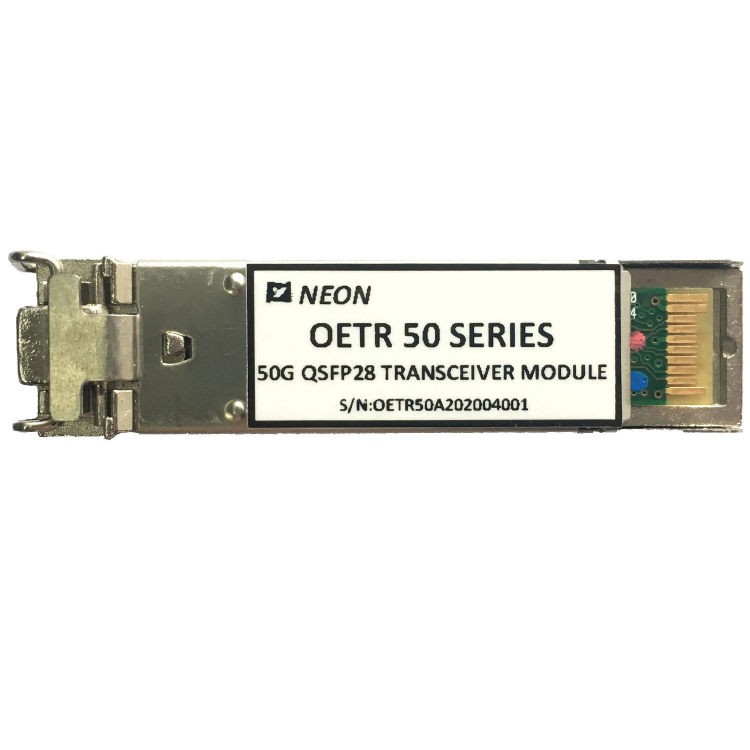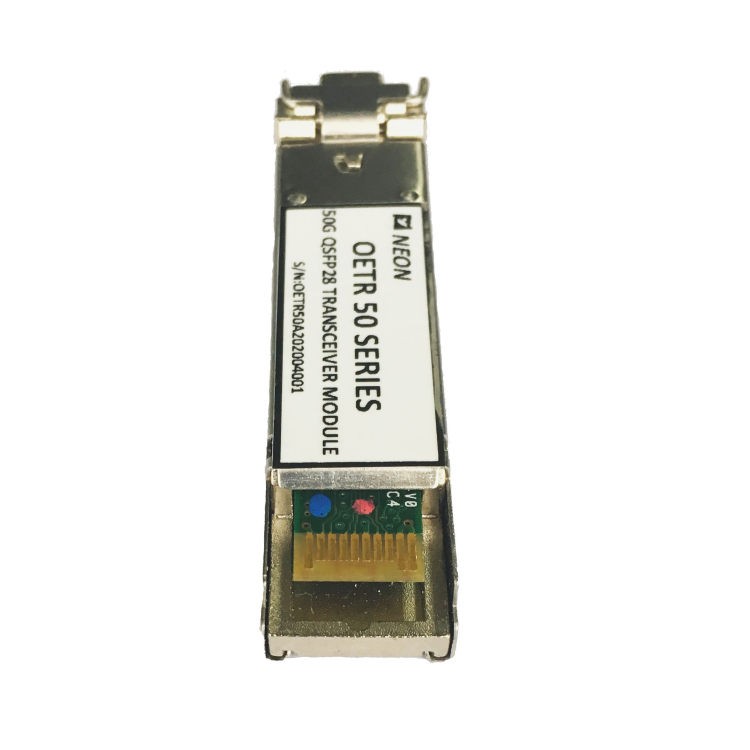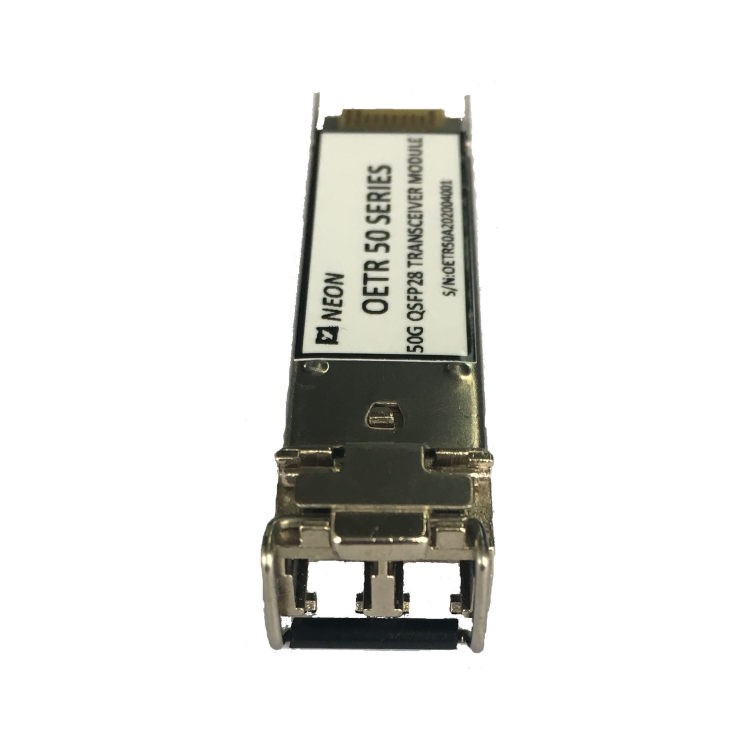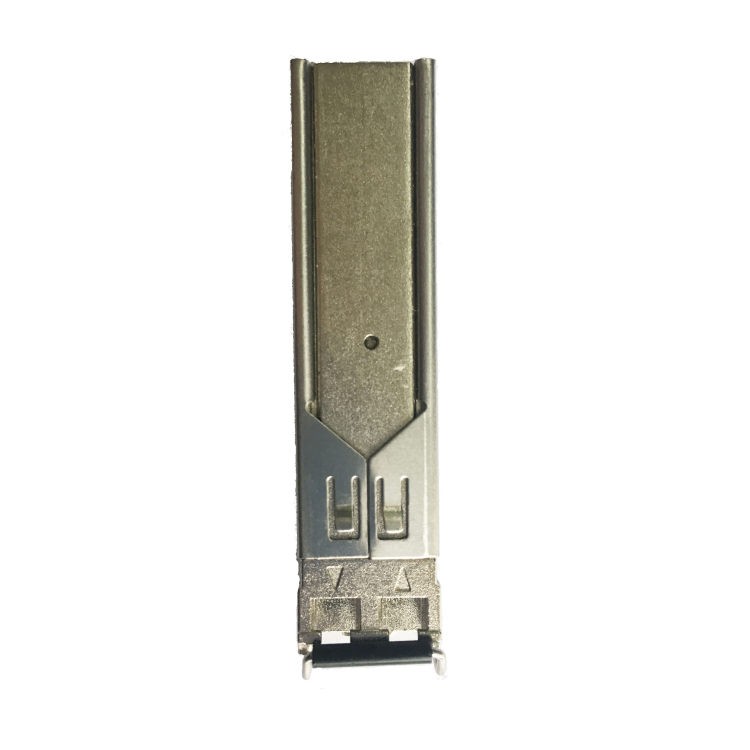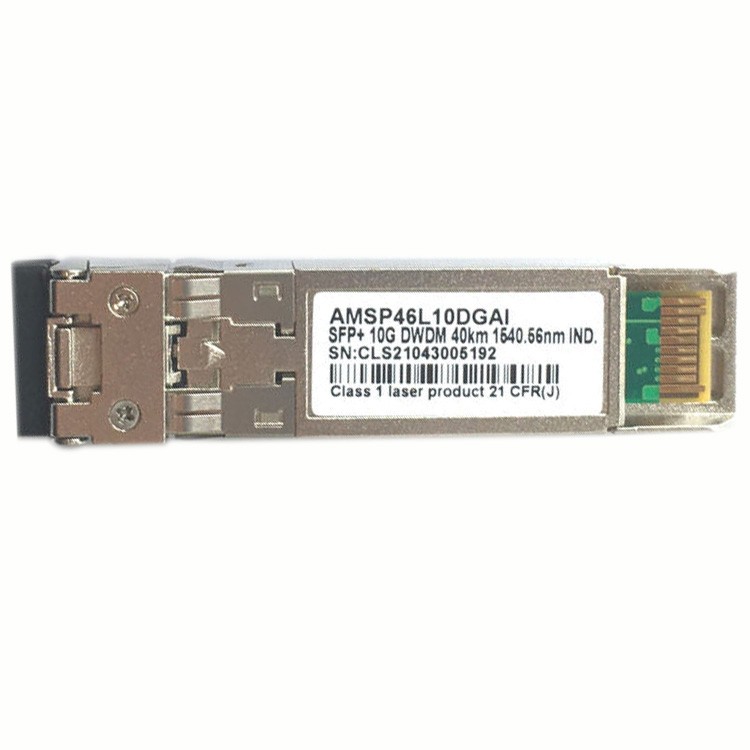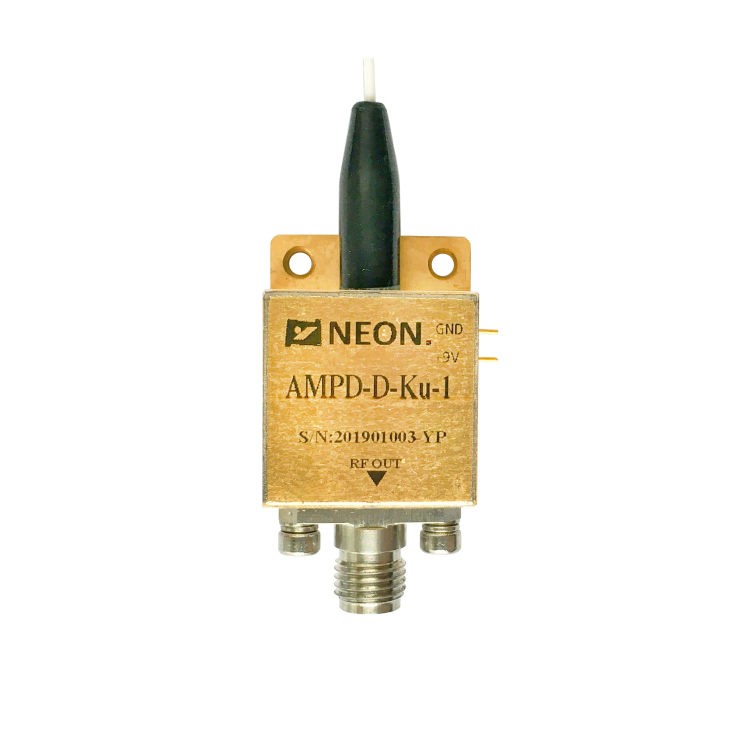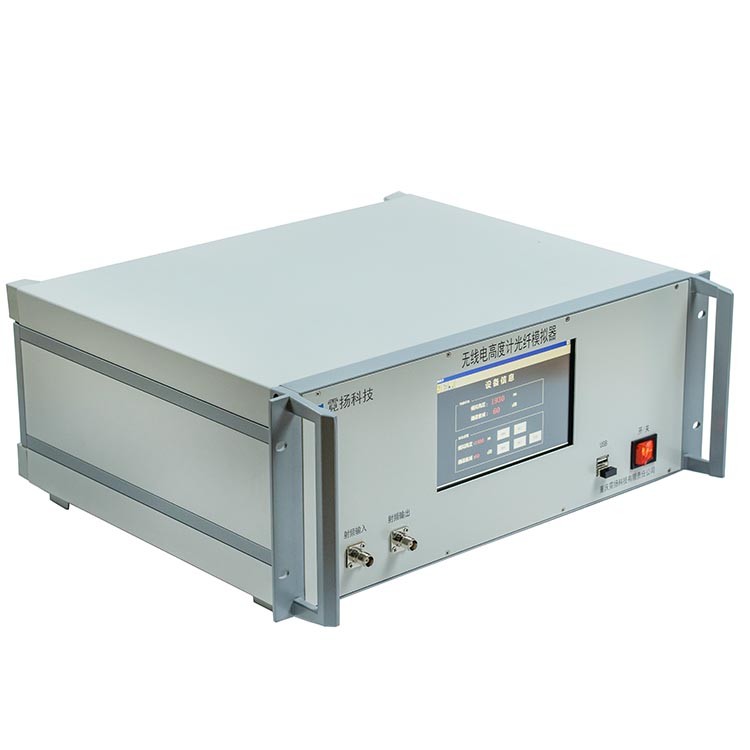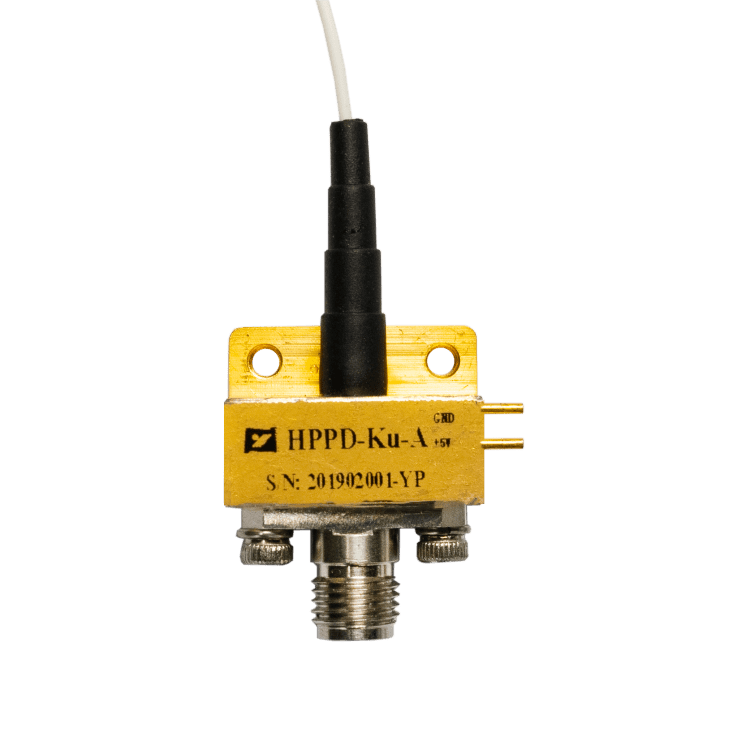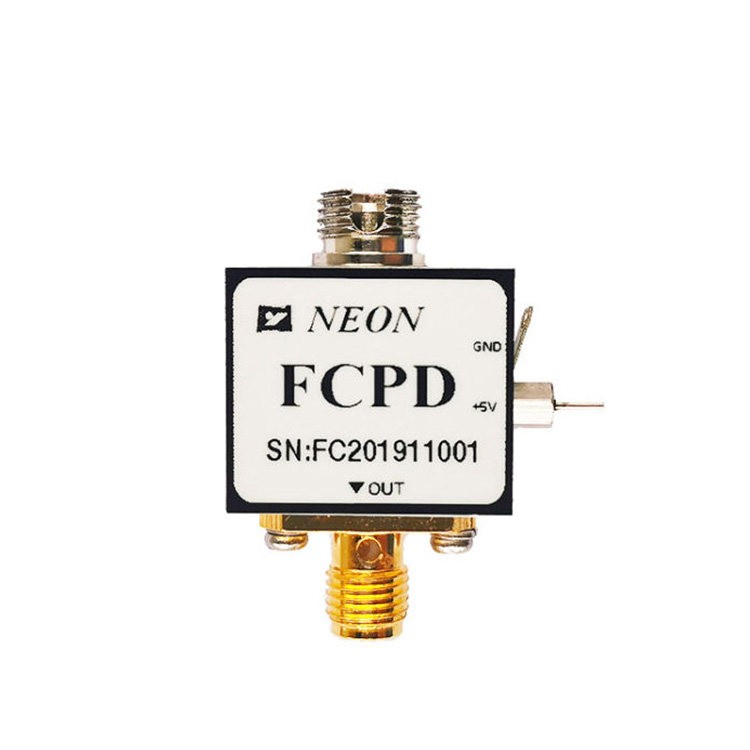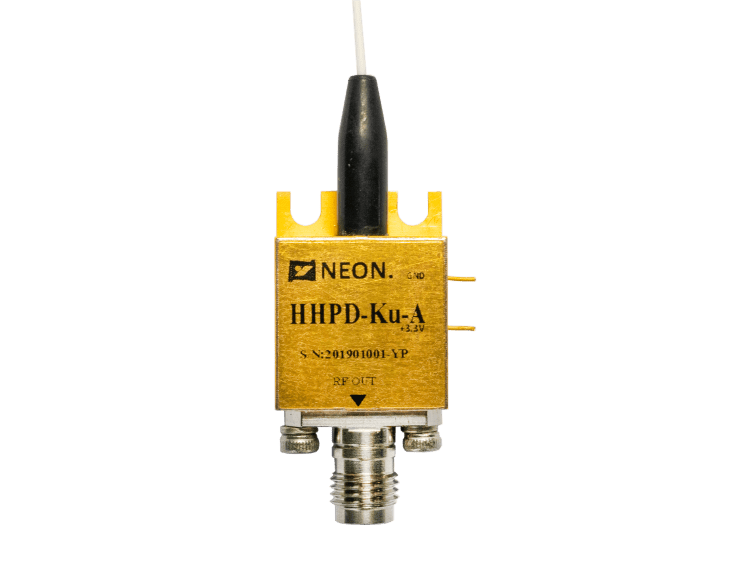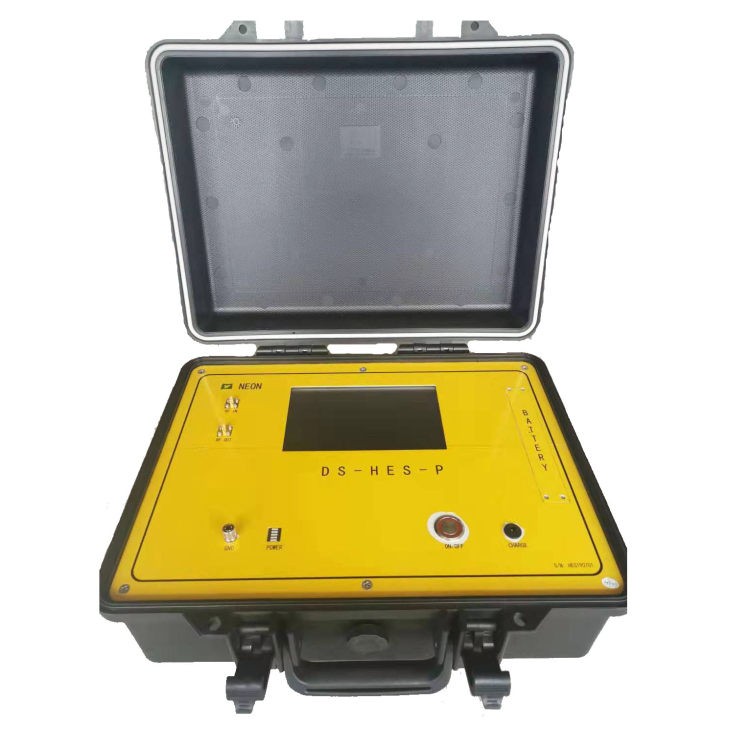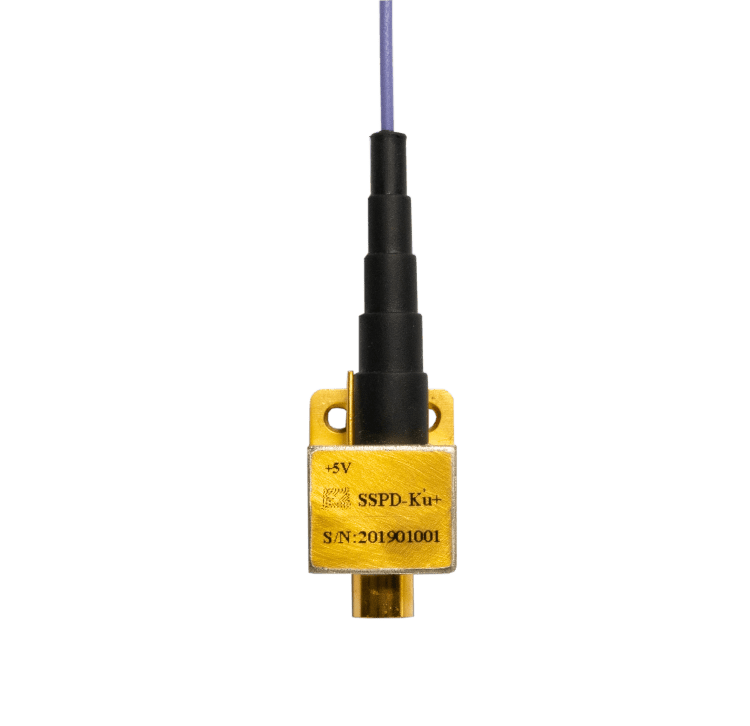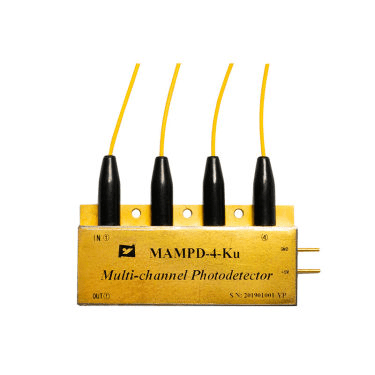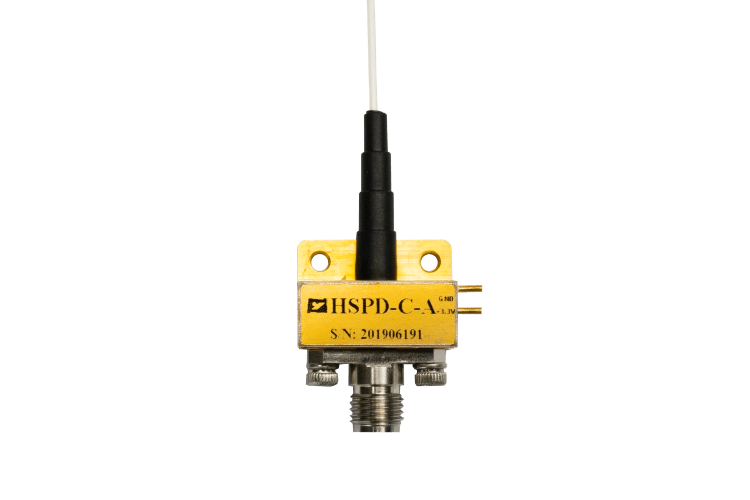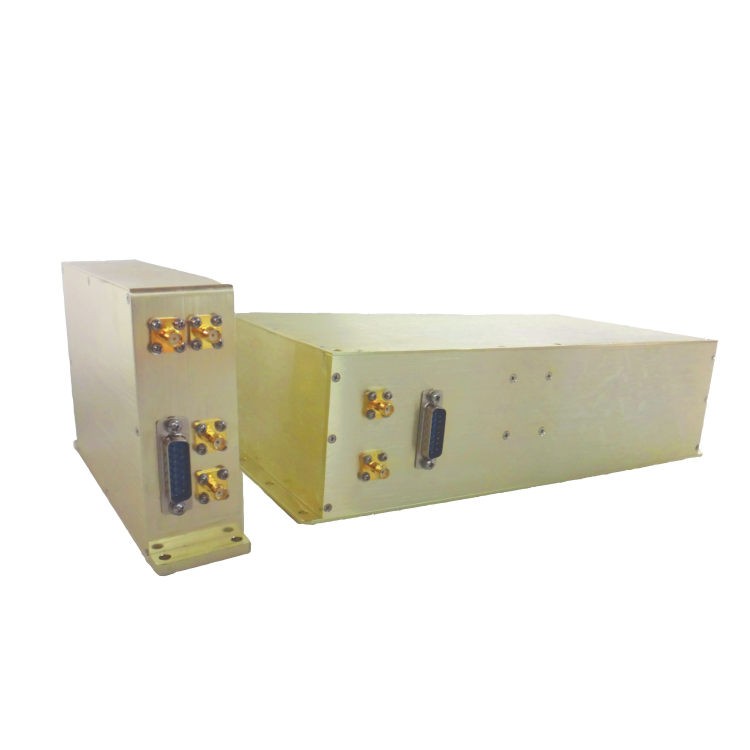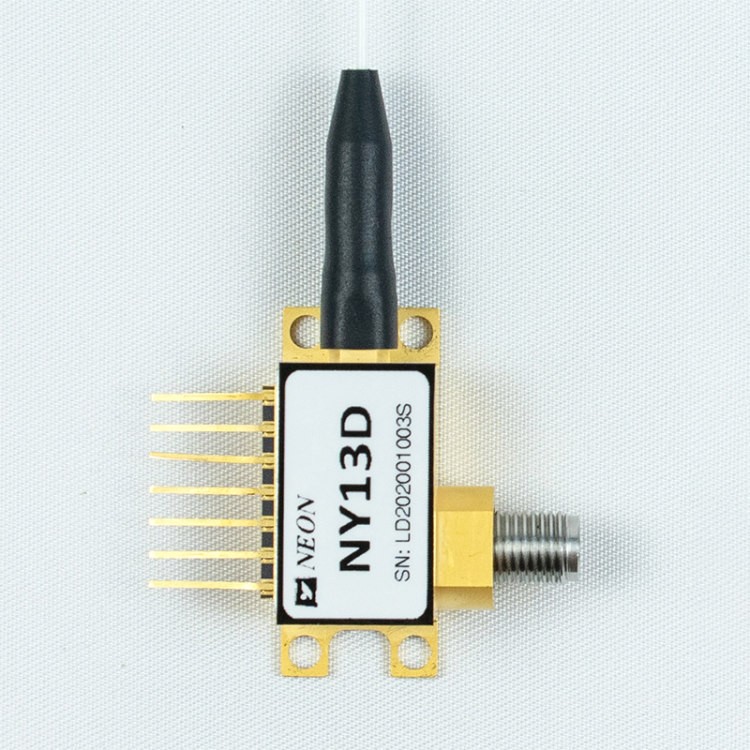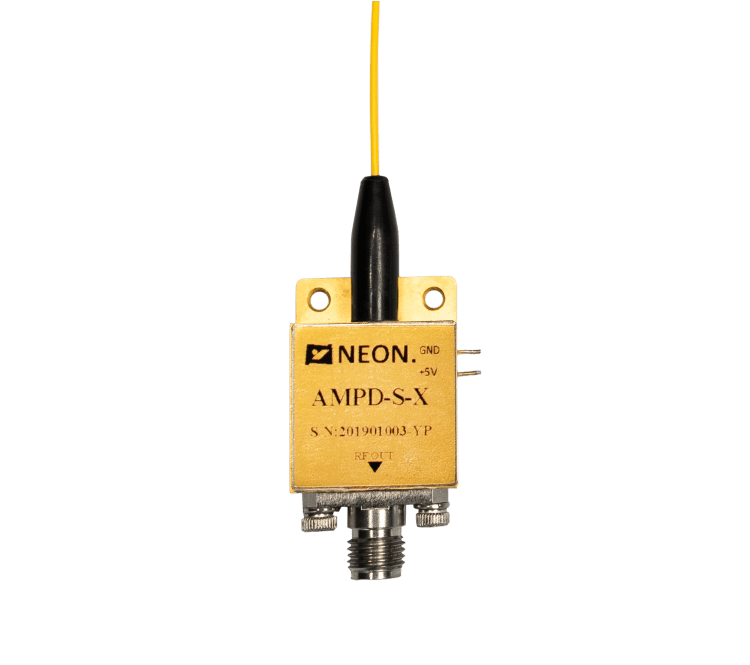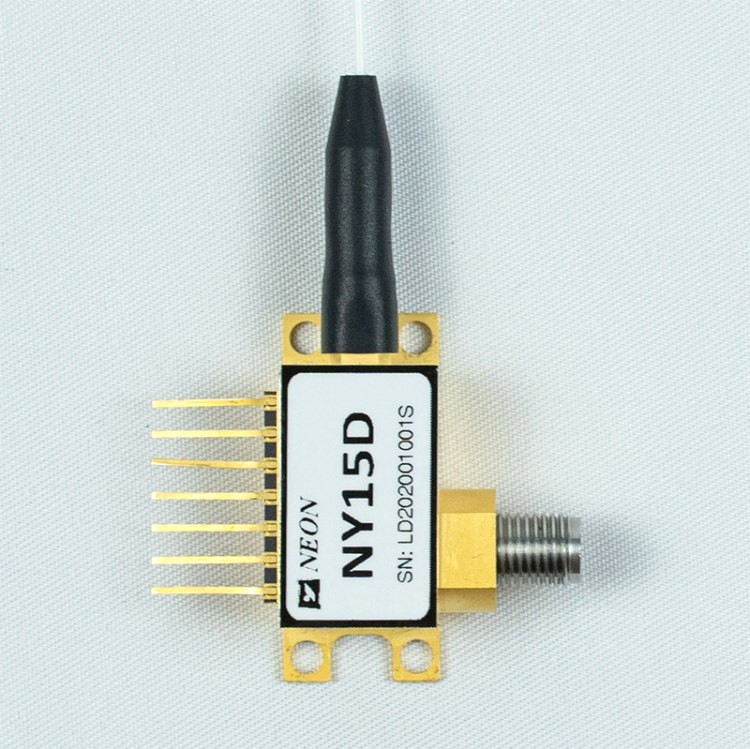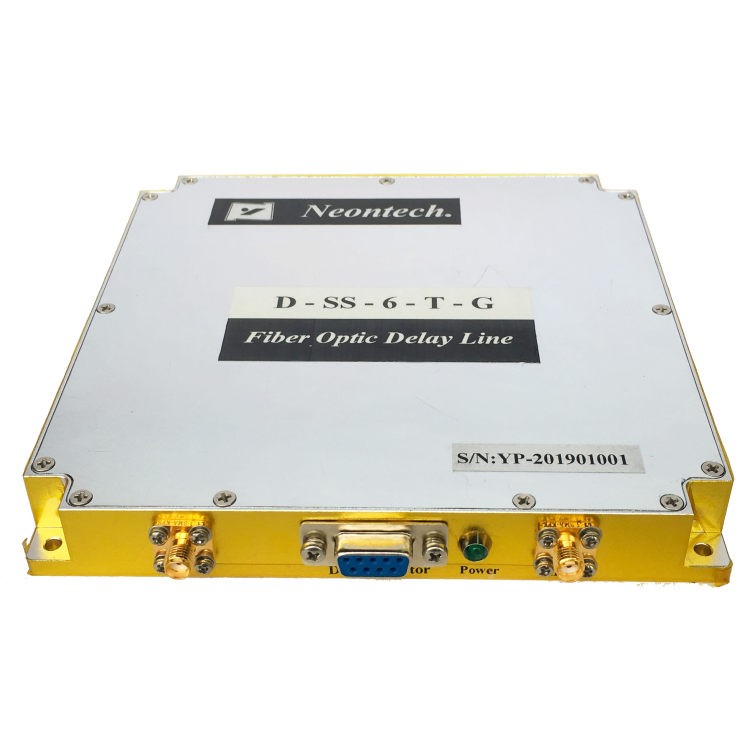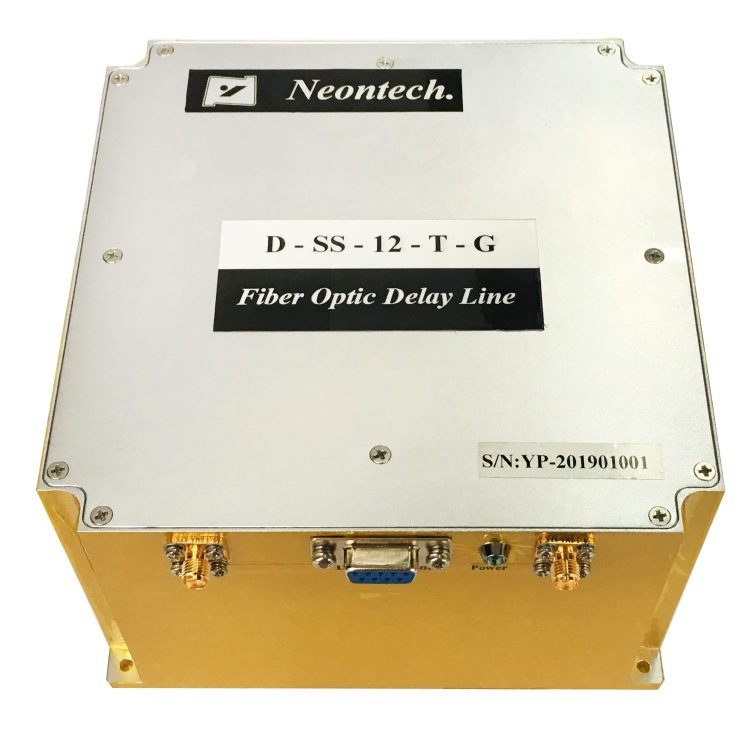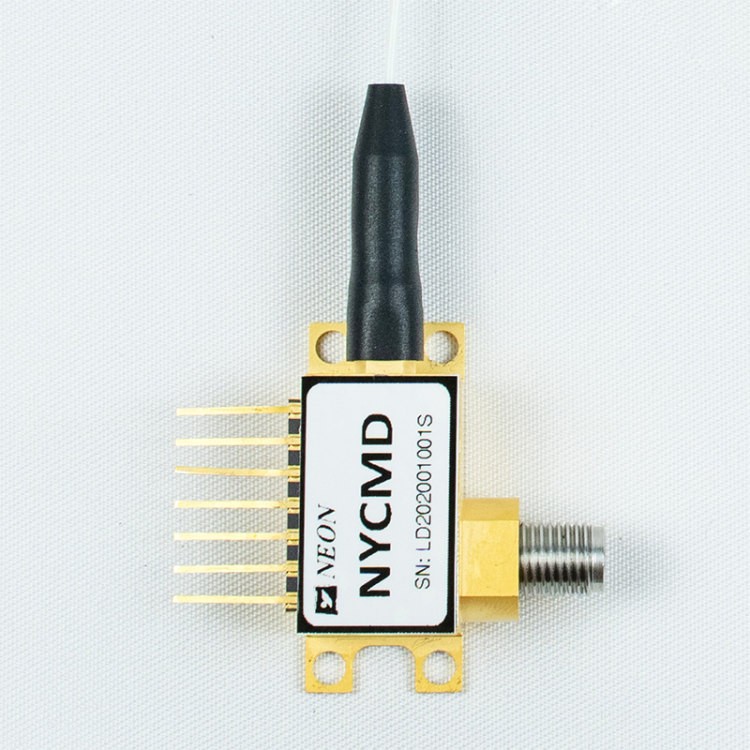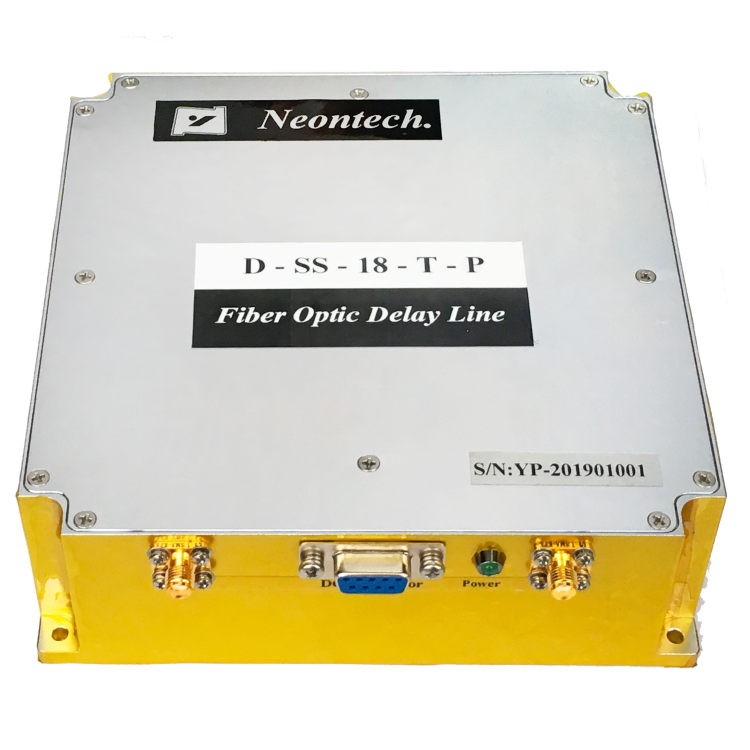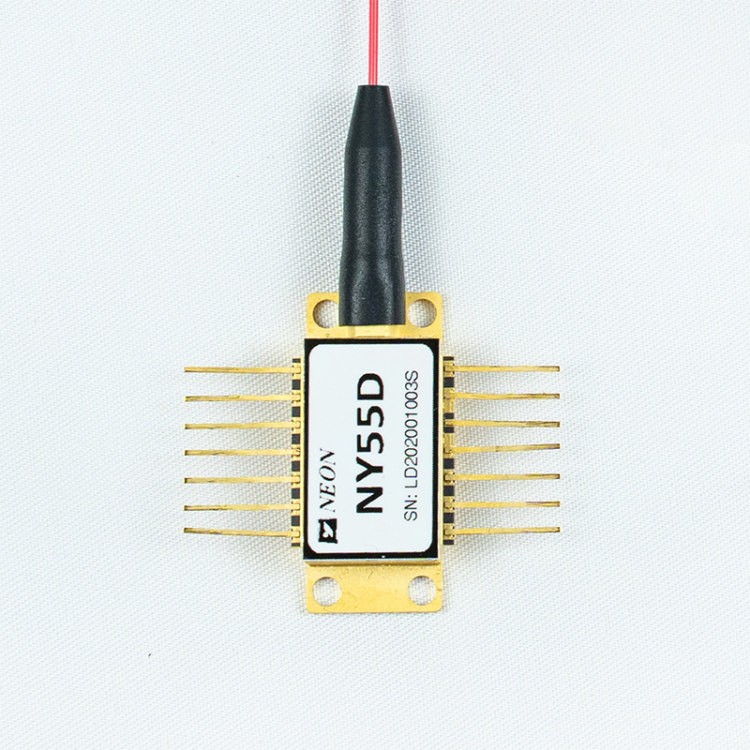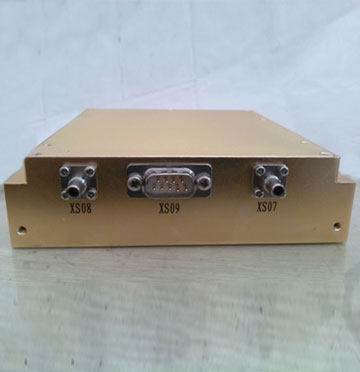OETR 50 Series – QSFP28 50G 10km SM PAM4 BIDI Transceiver
The Transmitter central wavelengths of each pair module are 1271 and 1331 nm, the receiver central wavelengths are 1331 and 1271 nm. It contains a single LC connector for the optical interface and a 38-pin connector for the electrical interface. Digital Diagnostics functions are available via a 2-wire serial interface, as specified SFF-8636.free).
Introduction of the OETR 50 Series QSFP28 50G 10km SM PAM4 BIDI Transceiver
The NEON OETR 50 Series QSFP28 transceiver module is a high-performance, cost-effective module for 50 Gigabit Ethernet links over single-mode fiber. They are compliant with the QSFP28 MSA, and IEEE 802.3cd. The optical transceiver integrated with DSP translated two lans 26.56GBd NRZ to 26.56GBd PAM4.
Features of the QSFP28 50G 10km SM PAM4 BIDI Transceiver
Hot-pluggable QSFP28 form factor and Compliant with QSFP+ MSA.
I2C management interface
Single LC connector for BIDI
Power dissipation < 3.5W
0°C to 70°C Commercial Temperature Range
Single 3.3V power supply
Maximum link length of 10km on Single-Mode Fiber(SMF)
IEEE STD 803.3cd Compliant
50GAUI-2 Serial Electrical Interface support
Optical 26.56GBaud PAM4
RoHS-6 compliant (lead-free)
Standards of the QSFP28 50G 10km SM PAM4 BIDI Transceiver
Compliant with QSFP+ MSA.
Compliant with SFF-8636
Compliant with IEEE802.3cd
Compliant with IEEE802.3bm
Compliant with RoHS6
Applications of the QSFP28 50G 10km SM PAM4 BIDI Transceiver
50G LR applications
Other Optical Links
Specifications of NEON’s QSFP28 50G 10km SM PAM4 BIDI Transceiver
| Table1-Absolute Maximum Ratingster | |||||
| Parameter | Symbol | Min | Typ. | Max | Unit |
| Storage Temperature Range | Ts | -40 | 85 | ℃ | |
| Operating case temperature Top | Top | -5 | 75 | ||
| Relative Humidity(non-condensing) | RH | 5 | 85 | % | |
| Power Supply Voltage | Vcc | -0.5 | 4 | V | |
| Receiver Damage Threshold | PT | 5.2 | dBm | ||
| ESD Sensitivity | ±500 for High-speed lines ±2kV for others | V | |||
| Table2-Recommended Operating Conditions | |||||
| Parameter | Symbol | Min | Typ. | Max | Unit |
| Operating Case Temperature Range | Tc | 0 | – | 70 | ℃ |
| Power Supply Voltage | Vcc | 3.135 | 3.3 | 3.465 | V |
| Data Rate(Electrical) | DRe | 26.5625 | Gbps | ||
| Data Rate(Optical) | DRo | 53.125 | Gbps | ||
| Transmission Distance | 2 | 10000 | |||
Tested under recommended operating conditions, unless otherwise noted
| Table3-Transmitter Operating Characteristic-Optical | ||||||
| Parameter | Symbol | Min | Typ. | Max | Unit | Note |
| Signaling Rate(range) | 26.5625 ± 100 ppm | GBd | ||||
| Wavelengths (range) | WL | 1264.5 | 1271 | 1277.5 | nm | 1 |
| 1324.5 | 1331 | 1337.5 | ||||
| Module Format | PAM4 | |||||
| Average Launch Power | PAVG | -4.5 | 4.2 | dBm | 2 | |
| Optical modulation amplitude | POMA | -1.5 | 4 | dBm | 3 | |
| (OMA) | ||||||
| Side-Mode Suppression Ratio | SMSR | 30 | dB | |||
| Extinction Ratio | ER | 3.5 | dB | |||
| Launch power in OMA minus TDECQ(min) | -2.9 | dB | ||||
| Transmitter and dispersion eye | 3.2 | dB | ||||
| closure for PAM4 (TDECQ)(max) | ||||||
| Average launch power of OFF transmitter(max) | -16 | dBm | ||||
| RIN OMA(max) | -132 | dB/Hz | ||||
| Optical return loss tolerance(max) | 15.6 | dB | ||||
| Transmitter Reflectance(max) | -26 | dB | 4 | |||
Notes:
[1] See Ordering Information
[2] Min average power is informative and not the principal indicator of signal strength. Power below this value cannot be
compliant; however, a value above this does not ensure compliance
[3] Even if the TDECQ < 1.4 dB, the OMAouter (min) must exceed this value
[4] Transmitter reflectance is defined as looking into the transmitter
| Table4-Receiver Operating Characteristic-Optical | ||||||
| Parameter | Symbol | Min | Typ. | Max | Unit | Note |
| Signaling Rate(range) | 26.5625 ± 100 ppm | GBd | ||||
| Wavelengths (range) | WL | 1264.5 | 1271 | 1277.5 | nm | 1 |
| 1324.5 | 1331 | 1337.5 | ||||
| Damage threshold | 5.2 | dBm | 2 | |||
| Average receive power | -10.8 | 4.2 | dBm | 3 | ||
| LOS Assert | LOSA | -30 | 18 | dBm | ||
| LOS De-Assert | LOSD | -15 | dBm | |||
| LOS Hysteresis | 0.5 | dB | ||||
| Receiver Sensitivity (OMA) | RS | -8.9 | dBm | 4 | ||
| Stressed Receiver Sensitivity (OMA) | RSS | -6.4 | dBm | 5 | ||
| Receiver Reflectance | -26 | dB | ||||
| Condition of Stressed sensitivity test | ||||||
| Stressed Eye Closure | SECQ | 3.2 | dB | 6 | ||
Notes:
[1] See ordering information
[2] The receiver shall be able to tolerate, without damage, continuous exposure to an optical input signal having this average power level
[3] Average receive power (min) is informative and not the principal indicator of signal strength. A received power below this value cannot be compliant; however, a value above this does not ensure compliance
[4] Receiver sensitivity (OMAouter) (max) is informative and is defined for a transmitter with a value of SECQ up to 3.2 dB for 50GBASE-LR, The BER is below 2.4E-5 before FEC at the beginning of life and below 2.4E-4 before FEC at the end of life
[5] Measured with conformance test signal at TP3 (see 139.7.10) for the BER specified in 139.1.1 (IEEE802.3cd)
[6] These test conditions are for measuring stressed receiver sensitivity. They are not characteristics of the receiver
Table5- Operating Characteristic- Electrical | |||||
| Parameter | Symbol | Min | Typ. | Max | Unit |
| Input Differential Impedance | 100 | Ω | |||
| Differential Data Input Swing | 900 | mV | |||
| Differential Data Output Swing | 900 | mV | |||
| Table6- Digital Diagnostic Functions | |||||
| Parameter | Symbol | Min | Max | Unit | Note |
| Temperature monitor absolute error | DMI_Temp | -3 | 3 | degC | |
| Supply voltage monitor absolute error | DMI _VCC | -5% | 5% | Full operating range | |
| Channel RX power monitor absolute error | DMI_RX | -3 | 3 | dB | |
| Channel Bias current monitor | DMI_Ibias | -10% | 10% | ||
| Channel TX power monitor absolute error | DMI_TX | -3 | 3 | dB | |
| Table7- Control and Status I/O Timing Characteristics | |||||
| Parameter | Symbol | Min | Max | Unit | Note |
| Initialization time | t_init | 2000 | ms | 1 | |
| Reset Init Assert Time | t_reset_init | 10 | us | 2 | |
| Serial Bus Hardware Ready Time | t_serial | 2000 | ms | 3 | |
| Reset Assert Time | t_reset | 2000 | ms | 4 | |
| LPMode Assert Time | ton_LPMode | 100 | us | 5 | |
| LPMode Deassert Time | Toff_LPMode | 500 | ms | 6 | |
| IntL Assert Time | ton_IntL | 200 | ms | 7 | |
| IntL Deassert Time | toff_IntL | 500 | us | 8 | |
| Rx LOS Assert Time | ton_los | 100 | ms | 9 | |
| Tx Fault Assert Time | ton_Txfault | 200 | ms | 10 | |
| Flag Assert Time | ton_flag | 200 | ms | 11 | |
| Mask Assert Time | ton_mask | 100 | ms | 12 | |
| Mask Deassert Time | toff_mask | 100 | ms | 13 | |
| Power_override or Power_set Assert Time | ton_Pdown | 100 | ms | 14 | |
| Power_override or Power_set Deassert Time | toff_Pdown | 600 | ms | 15 | |
Notes:
[1] Time from power on, hotplug, or rising edge of reset until the module is fully functional. This time does not apply to non-Power level 0 modules in Low Power State.
[2] A Reset is generated by a low level longer than t_reset_init present on the reset input.
[3] Time from power on until the module responds to data transmission over the two-wire serial bus.
[4] Time from the assertion of LPMode (Vin: LPMode = Vih) until module power consumption reaches Power Level 1.
[5] Time from deassertion of LPMode (Vin: LPMode = Vil) until the module is fully functional.
[6] Time from the occurrence of condition triggering IntL until Vout: IntL=Vol.
[7] Time from clear on reading operation of the associated flag until Vout: IntL=Voh. This includes dessert times for Rx LOS, Tx Fault, and other flag bits.
[8] Time from Rx LOS state to Rx LOS bit set (value = 1b) and Intl asserted.
[9] Time from Tx Fault state to Tx Fault bit set (value = 1b) and Intl asserted.
[10] Time from condition triggering flag to associated flag bit set (value = 1b) and IntL asserted.
[11] Time from mask bit set (value = 1b) until associated IntL assertion is inhibited.
[12] Time from mask bit cleared (value = 0b) until associated IntL operation resumes.
[13] Time from the change of state of Application or Rate Select bit until transmitter or receiver bandwidth is in conformance with the appropriate specification.
[14] Time from P_Down bit set (value = 1b) until module power consumption reaches Power Level 1
[15] Time from P_Down bit cleared (value = 0b) until module is fully functional.
| Pin-out Definition | Block Diagram of Transceiver |
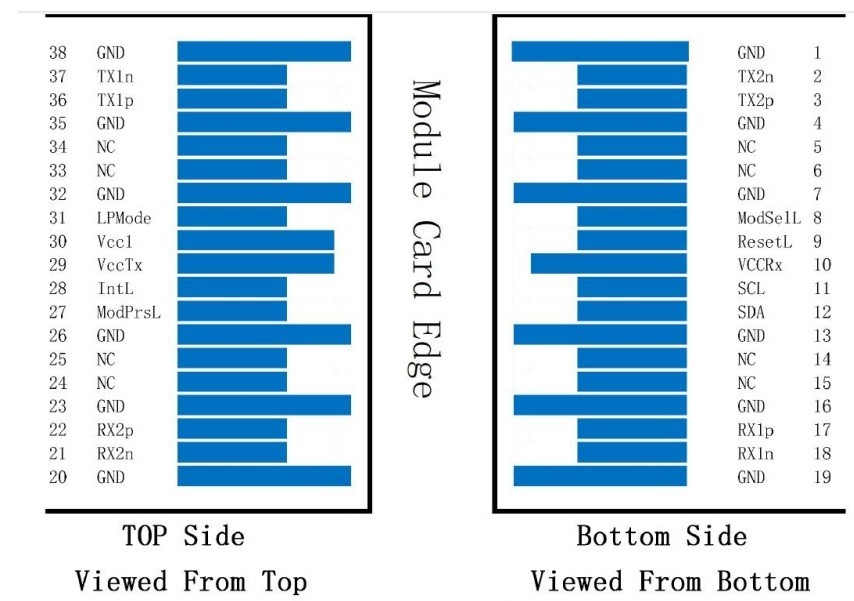 | 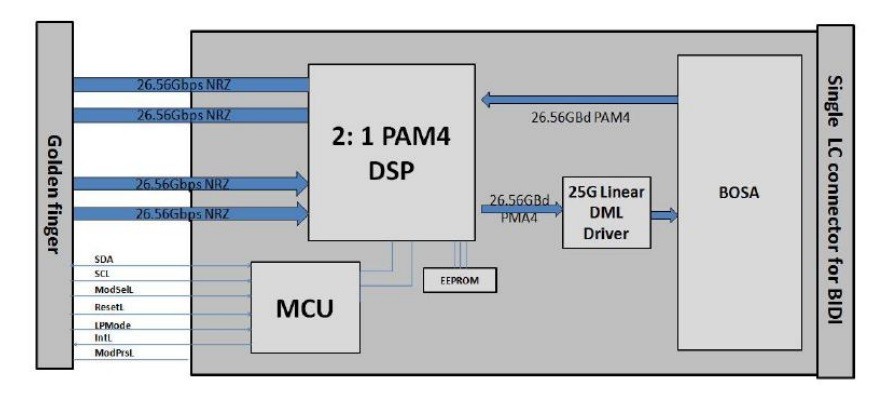 |
| Table8-Pin Function Definitions | |||
| Pin | Name | Description | Notes |
| 1 | GND | Ground | 1 |
| 2 | Tx2n | Transmitter Inverted Data Input | |
| 3 | Tx2p | Transmitter Non-Inverted Data Input | |
| 4 | GND | Ground | 1 |
| 5 | NC | 3 | |
| 6 | NC | 3 | |
| 7 | GND | Ground | 1 |
| 8 | ModSelL | Module Select | |
| 9 | ResetL | Module Reset | |
| 10 | Vcc Rx | +3.3V Power Supply Receiver | 2 |
| 11 | SCL | 2-wire serial interface clock | |
| 12 | SDA | 2-wire serial interface data | |
| 13 | GND | Ground | 1 |
| 14 | NC | 3 | |
| 15 | NC | 3 | |
| 16 | GND | Ground | 1 |
| 17 | Rx1p | Receiver Non-Inverted Data Output | |
| 18 | Rx1n | Receiver Inverted Data Output | |
| 19 | GND | Ground | 1 |
| 20 | GND | Ground | |
| 21 | Rx2n | Receiver Inverted Data Output | |
| 22 | Rx2p | Receiver Non-Inverted Data Output | |
| 23 | GND | Ground | 1 |
| 24 | NC | 3 | |
| 25 | NC | 3 | |
| 26 | GND | Ground | 1 |
| 27 | ModPrsL | Module Present | |
| 28 | IntL | Interrupt | |
| 29 | VccTx | +3.3V Power supply transmitter | 2 |
| 30 | Vcc1 | +3.3V Power supply | 2 |
| 31 | LPMode | Low Power Mode | |
| 32 | GND | Ground | 1 |
| 33 | NC | 3 | |
| 34 | NC | 3 | |
| 35 | GND | Ground | 1 |
| 36 | Tx1p | Transmitter Non-Inverted Data Input | |
| 37 | Tx1n | Transmitter Inverted Data Input | |
| 38 | GND | Ground | 1 |
Notes:
[1] GND is the symbol for signal and supply (power) common for the QSFP+ module. All are common within the QSFP+ module and all module voltages are referenced to this potential unless otherwise noted. Connect these directly to the host board signal-common ground plane
[2] Vcc Rx, Vcc1, and VccTx are the receiver and transmitter power supplies and shall be applied concurrently. Recommended host board power supply filtering is shown in Figure 3. Vcc Rx Vcc1 and VccTx may be internally connected within the QSFP+ Module in any combination. The connector pins are each rated for a maximum current of 500 mA
[3] NC is Not Connect
Recommended Interface Circuit
The host board should use the power supply filtering equivalent to that shown in Figure 4. Any voltage drop across a filter network on the host is counted against the host DC setpoint accuracy specification. Inductors with a DC resistance of less than 0.1 Ohm should be used in order to maintain the required voltage at the Host Edge Card Connector. It is recommended that the 22 uF capacitors each have an equivalent series resistance of 0.22 ohm.
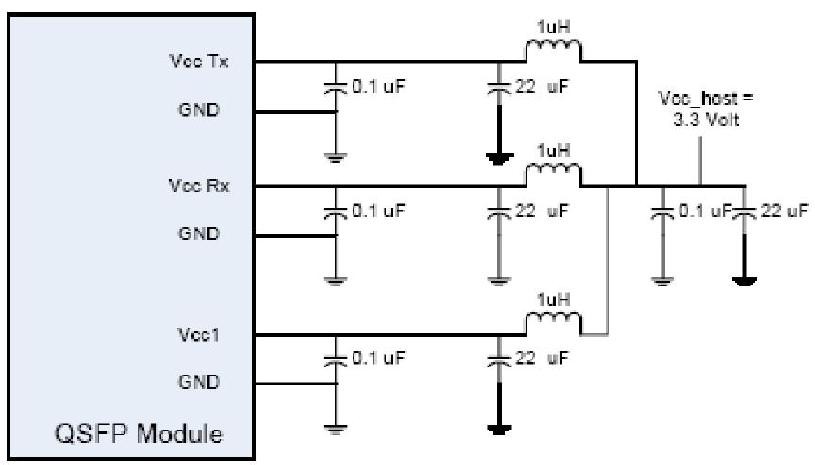
Mechanical Dimensions( Unit: mm )
The unit is a millimeter.
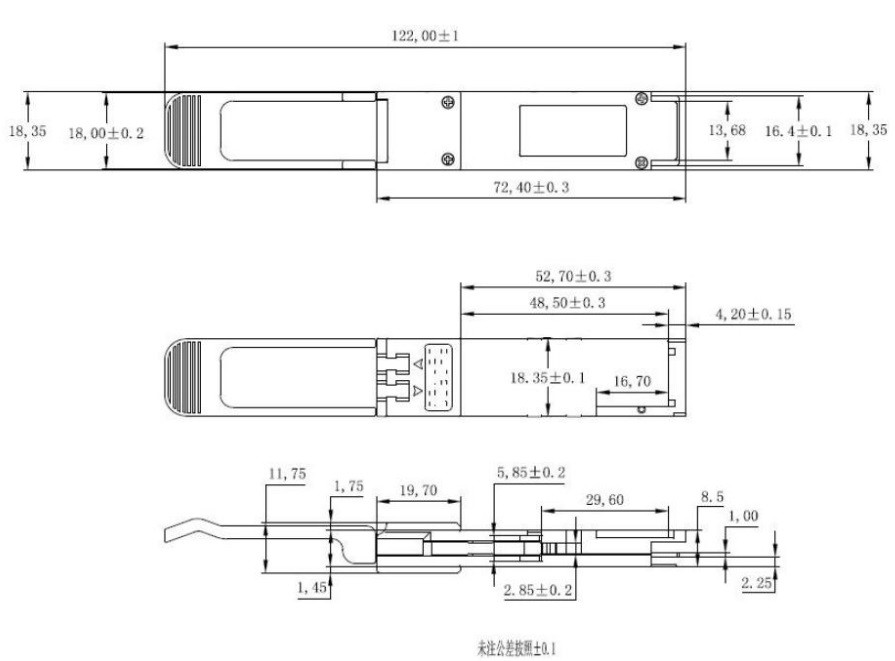
Digital Diagnostic Memory Map
2-Wire Serial Address: 1010000x(A0H)
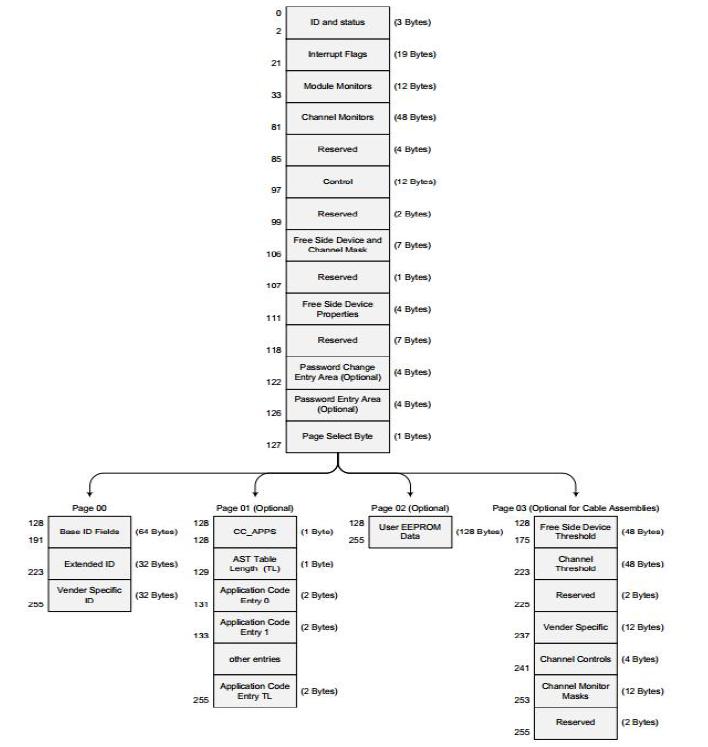
EEPROM Information
| Table9-EEPROM Serial ID Memory Contents (Upper page 00h) | ||||
| Addr. | Field Size | Name of Field | Hex | Description |
| (Bytes) | ||||
| 128 | 1 | Identifer | 11 | QSFP28 |
| 129 | 1 | Ext. Identifier | CC | Serial ID module |
| 130 | 1 | Connector | 7 | LC Connector |
| 131-138 | 8 | Transceiver | 80 00 00 00 00 00 00 00 | |
| 139 | 1 | Encoding | 8 | PAM4 |
| 140 | 1 | Nominal Bit Rate | FF | See Byte 222 |
| 141 | 1 | Rate Select | 0 | Not compliant |
| 142 | 1 | Link Length(Standard | 0A | Transceiver transmit distance,10*km |
| SM Fiber) | ||||
| 143 | 1 | Link Length(OM3) | 0 | Not compliant |
| 144 | 1 | Link Length(OM2) | 0 | Not compliant |
| 145 | 1 | Link Length(OM1) | 0 | Not compliant |
| 146 | 1 | Link Length(Cooper) | 0 | Not compliant |
| 147 | 1 | Device Tech | 40 | 1310nm DFB; No wavelength control; Uncooled transmitter device; PINdetector; Transmitter not tuneable |
| 148-163 | 16 | Vendor name | 48 47 20 47 45 4E 55 49 4E 45 20 20 | “NEON” Vendor Name(ASCII) |
| 164 | 1 | Electronic or optical interfaces for InfiniBand | 0 | |
| 165-167 | 3 | Vendor OUI | 00 00 00 | |
| 168-183 | 16 | Vendor PN | 4D 54 52 51 2D 31 4C 41 30 32 2D 33 33 42 20 20 | “OETR-50-A”Part No.(ASCII) For TX1330nM |
| 4D 54 52 51 2D 31 4C 41 30 32 2D 32 37 42 20 20 | “OETR-50-B”Part No.(ASCII) For TX1270nM | |||
| 184-185 | 2 | Vendor rev | 41 30 | |
| 186-187 | 2 | Wavelength | 67 E8 | Transceiver wavelength, 1330nm |
| 63 38 | Transceiver wavelength, 1270nm | |||
| 188-189 | 2 | Wavelength | 05 14 | ±6.5nm |
| Tolerance | ||||
| 190 | 1 | Max Case Temp | 46 | Max Case Temp 70°C |
| 191 | 1 | Check Sum | B2 | OETR-50-A Address 128-190 Checksum |
| 1 | OETR-50-B Address 128-190 Checksum | |||
| 192-195 | 4 | Rate Select,TX | 00 08 00 98 | |
| Disable,TX Fault,LOS,Warmingindicators | ||||
| 196-211 | 16 | Vendor SN | SN(Variable) | Serial Number of transceiver(ASCII). |
| 212-219 | 8 | Date code | DC(Variable) | Manufactory Date Code. |
| 220 | 1 | Diagnostic Monitoring Type | 0C | Average Power |
| 221 | 1 | Enhanced Options | 10 | |
| 222 | 1 | Extended bit rate | D5 | Nominal bit rate per lane, units of 250 Mbps- |
| 223 | 1 | Check Sum | (Variable) | Address 192-222 |
| 224-225 | Reserved | Read only | Filled by zero | |
| Table10-EEPROM DDM Alarm & Warning Threshold (Upper page 03h) | ||||
| Addr. | Field Size | Name of Field | Hex | Description |
| (Bytes) | ||||
| 128-129 | 2 | Temperature High Alarm | 50 00 | 80℃ |
| 130-131 | 2 | Temperature Low Alarm | F6 00 | -10℃ |
| 132-133 | 2 | Temperature High Warning | 46 00 | 70℃ |
| 134-135 | 2 | Temperature Low Warning | 00 00 | 0℃ |
| 144-145 | 2 | Vcc High Alarm | 8D CC | 3.63V |
| 146-147 | 2 | Vcc Low Alarm | 74 04 | 2.97V |
| 148-149 | 2 | Vcc High Warning | 87 5A | 3.465V |
| 150-151 | 2 | Vcc Low Warning | 7A 76 | 3.135V |
| 176-177 | 2 | RX Power High Alarm | CD 00 | 7.2dBm |
| 178-179 | 2 | RX Power Low Alarm | 02 85 | -11.9dBm |
| 180-181 | 2 | RX Power High Warning | 66 BE | 4.2dBm |
| 182-183 | 2 | RX Power Low Warning | 05 08 | -8.9dBm |
| 184-185 | 2 | Bias High Alarm | AF C8 | 90mA |
| 186-187 | 2 | Bias Low Alarm | 09 C4 | 5mA |
| 188-189 | 2 | Bias High Warning | 9C 40 | 80mA |
| 190-191 | 2 | Bias Low Warning | 13 88 | 10mA |
| 192-193 | 2 | TX Power High Alarm | CD 00 | 7.2dBm |
| 194-195 | 2 | TX Power Low Alarm | 06 F2 | -4.5dBm |
| 196-197 | 2 | TX Power High Warning | 66 BE | 4.2dBm |
| 198-199 | 2 | TX Power Low Warning | 0D DC | -7.5dBm |
Ordering Information
| Table11- Ordering Information | |||||||||
| Part No | Specification | ||||||||
| Pack | Rate | Tx | Pout | Rx | S | Top | Reach | Others | |
| OETR-50-A | QSFP28 | 50G | DFB/1331 | -4.5~4.2dBm | PIN/1271 | <-8.9dBm | 0~70℃ | 10KM | DDM/RoHS |
| OETR-50-B | QSFP28 | 50G | DFB/1271 | -4.5~4.2dBm | PIN/1331 | <-8.9dBm | 0~70℃ | 10KM | DDM/RoHS |
Warmly welcome to contact us to learn more about the QSFP28 BIDI Transceiver and visit our factory at any time. Please feel free to let us know if there are any questions in Business.


